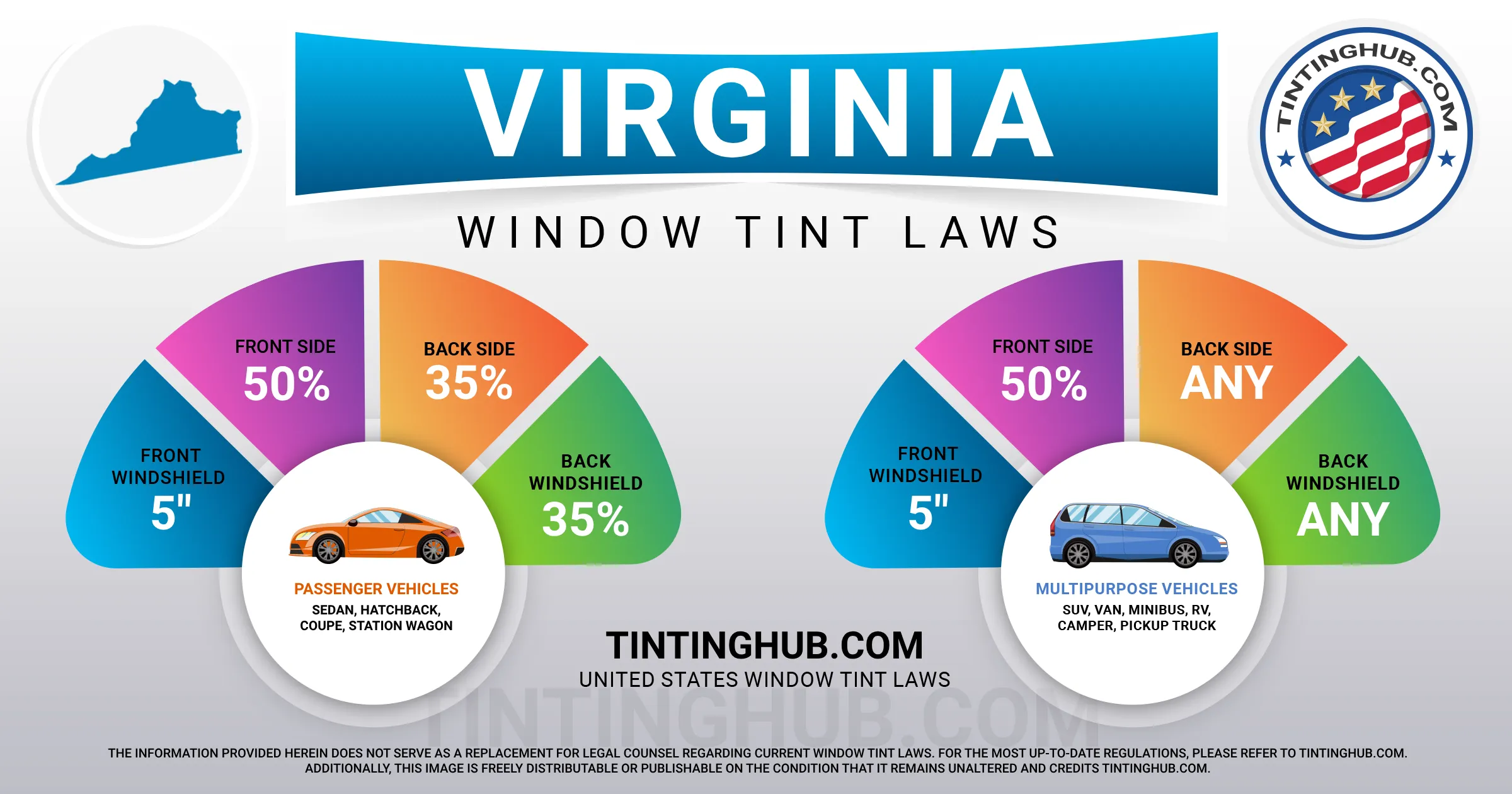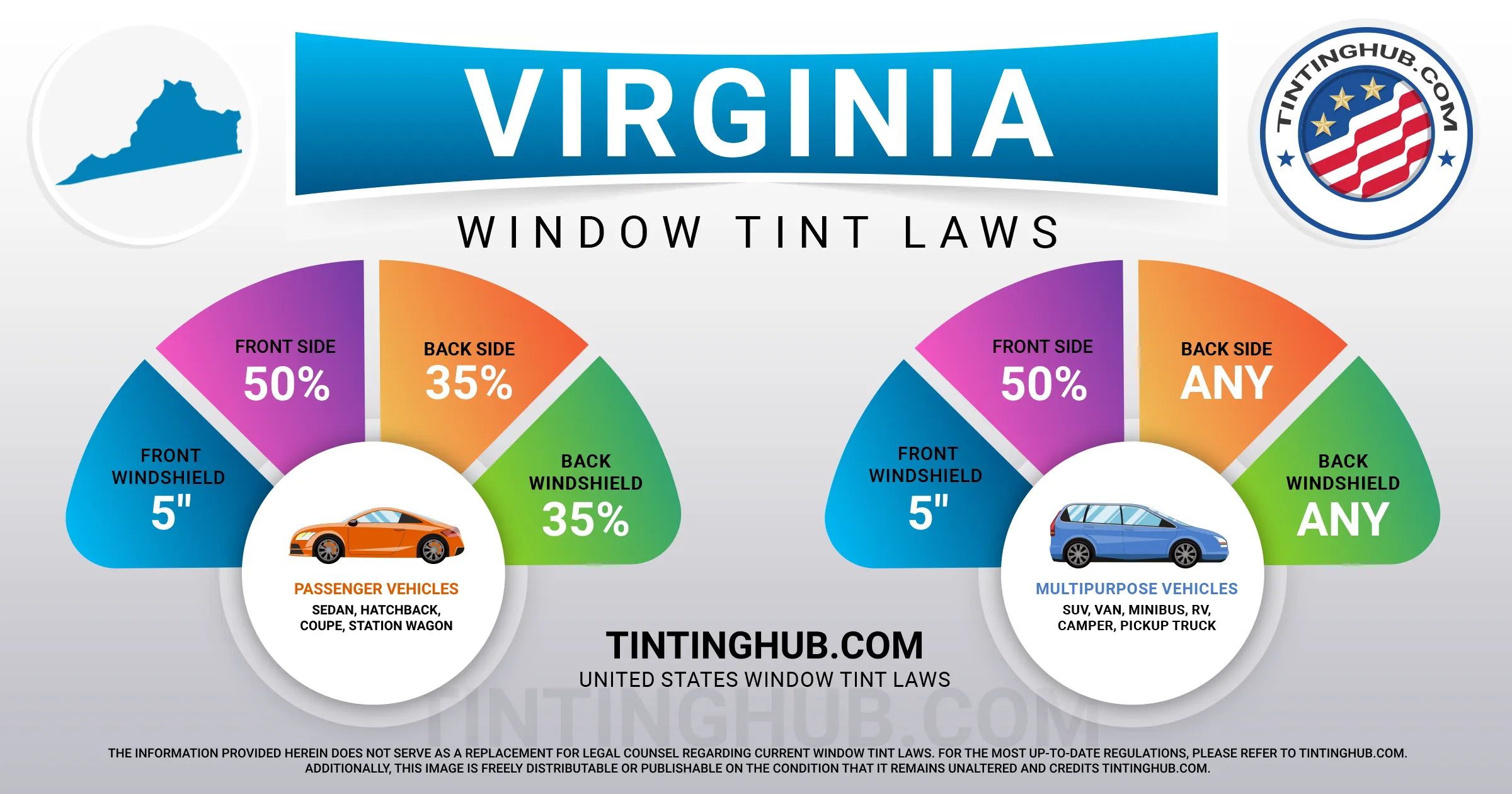Virginia Window Tint Laws (Last Update 2024)

If you’re a car owner in Virginia, it’s essential to stay informed about the state’s window tinting laws. These regulations, first enacted in 1999, govern the darkness and reflectiveness of window tint on vehicles. In this article, we’ll provide you with a detailed overview of Virginia’s window tinting laws, ensuring you’re well-informed and compliant.

Understanding VLT: Visible Light Transmission
Virginia law measures the darkness of window tint using Visible Light Transmission (VLT). The percentage of visible light allowed through your car’s windows varies depending on the type of vehicle.
Tint Darkness for Sedans
- Windshield: Non-reflective tint is permitted above the manufacturer’s AS-1 line (or the top 5 inches).
- Front Side Windows: These windows must allow more than 50% of light to pass through.
- Back Side Windows: The tint on the back side windows must allow more than 35% of light in.
- Rear Window: Similar to back side windows, the rear window tint must allow more than 35% of light in.
Tint Darkness for SUVs and Vans
- Windshield: Non-reflective tint is allowed above the manufacturer’s AS-1 line.
- Front Side Windows: These windows must allow more than 50% of light to pass through.
- Back Side Windows: SUVs and vans have the flexibility to use any level of tint darkness on their back side windows.
- Rear Window: Similar to back side windows, SUVs and vans can use any level of tint darkness on the rear window.
Medical Exemptions
For vehicles with medical exemptions, windshields may have 35% VLT on the top 5 inches (AS-1 line) or 70% VLT across the entire windshield. Front side windows may have up to 35% VLT.
Tint Reflection Regulations
Window tint can effectively reduce glare and heat by reflecting incoming light. Virginia law sets limits on the level of reflection allowed for tinted windows.
Tint Reflection for Sedans
- Front Side Windows: These windows must not be more than 20% reflective.
- Back Side Windows: The tint on the back side windows must not be more than 20% reflective.
Tint Reflection for SUVs and Vans
- Front Side Windows: These windows must not be more than 20% reflective.
- Back Side Windows: Similar to sedans, the tint on the back side windows of SUVs and vans must not be more than 20% reflective.
Additional Window Tint Rules in Virginia
Virginia has several other important laws and regulations related to window tinting, which you must be aware of:
- Side Mirrors: If any window is tinted, dual side mirrors are required in Virginia.
- Restricted Colors: Red, yellow, and amber window tints are not permitted.
- Tint Variance: A 7% variance in tint is allowed.
- Certificates: Film manufacturers are not required to certify the film they sell in Virginia.
- Stickers: The use of stickers is permitted, but the specifics are unspecified.
- Medical Exceptions: Virginia allows medical exemptions for special tint.
- Penalties: A first offense is considered a Class 3 misdemeanor, while subsequent offenses are treated as Class 2 misdemeanors.
Local Interpretations
Keep in mind that Virginia’s tinting laws and regulations may be interpreted differently in your specific county or place of residence. For the most accurate information, we recommend double-checking with your local Department of Motor Vehicles (DMV) or law enforcement authorities.
Our information about window tint laws in Virginia is current as of 2023. If you come across any outdated or incorrect information, please don’t hesitate to contact us, and we’ll make the necessary updates.
At [Your Company Name], we take pride in being a trusted industry leader, providing accurate and up-to-date information on window tint laws. Your compliance with these laws ensures safe and legal driving in the state of Virginia.